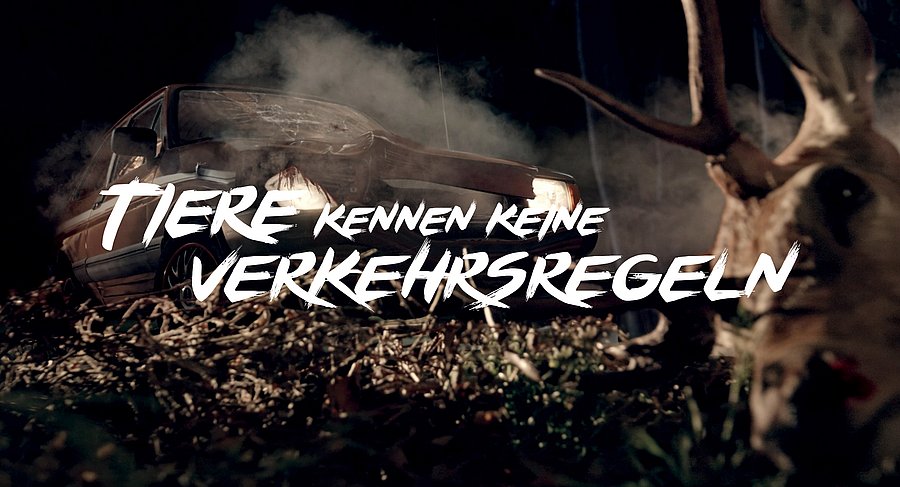
Attention deer crossing!
Diana Kaiser and Mareike Schlösser / Design and Art
Photo: Felix Brückner
Attention deer crossing!
Graduates of Bergische Universität film a spot about the dangers for road users when encountering wild animals.
What do an elephant and a deer have in common? - They don't know any traffic rules! They don't have to, but the dangers they pose in road traffic are considerable, both in Africa and in Europe. In Germany alone, there were a total of 284,000 deer accidents in 2021, according to the GDV (German Insurance Association). Internationally, red-framed triangular signs with native wild animals, including zebras, giraffes, jackals or even ostriches, among others, warn drivers that they could be dangerous. In our area, they represent wildlife crossing with the symbol of the leaping deer. The two graduates of the Faculty of Design and Art, Department of Media Design and Interior Design, Diana Kaiser and Mareike Schlösser, draw attention to the dangers of deer crossing with a road safety campaign in the form of a film spot entitled 'Animals know no traffic rules`. The film is about a fictitious wild animal accident caused by a passenger car. In order to sensitize people to this topic, the two academics work with the motif of an elephant.
Strong partners and source of information
While still studying for their master's degree in Public Interest Design, the two initiated the campaign as part of a study project because environmental issues are very close to their hearts. Under the leadership of Prof. Erica von Moeller, Junior Prof. Dr. Christoph Rodatz and Dr. Pierre Smolarski, a powerful short film was created to shake people up. The project was realized in cooperation with the Automobil-Club Verkehr (ACV) and the Deutscher Jagdverband (DJV). Press reports about game accidents in NRW are increasing, and the A1 and A 46 are also affected. To approach the topic, the makers first researched existing prevention measures, steps already implemented and ongoing projects. "There are, for example, the reflectors that are at the side of the road or in the fields, but also wild animal warnings and the like," reports Mareike Schlösser. The essential problem, she says, is primarily the fact that animals naturally cannot abide by any traffic rules, but the construction of roads is restricting or crossing more and more of the animals' paths. "The time change in spring and fall is also important, because unfortunately that's when especially many wildlife accidents occur." The question in the filmic realization was then above all: How do people become aware of wildlife accidents?
Driving schools and the time change
The only places where every future driver's license holder is informed about the possible dangers of passing game are the driving schools in Germany. Otherwise, deer accidents are reported in the media. "But it's always just reported on the topic itself, but people aren't made aware of it," says Schlösser. "And that was our approach. 'How can we get road users* to drive responsibly? "And then we looked, who is dealing with this issue?" continues Diana Kaiser, who directed the film. "In my research, I then came across the hunting association and the automobile club, for whom the topic is generally exciting." Kaiser gets in touch with the clubs, who pledge their support as cooperation partners.

Animals know no traffic rules
Photo: Felix Brückner
Tremendous forces are at work in a collision with wild animals.
According to the German Hunting Association (DJV), more than one million wild animals are killed in accidents every year, whereby a high number of unreported cases involving small animals must be taken into account in addition to reported wildlife accidents. In the case of a collision with a red deer at a speed of 60 km/h, the force of approximately five tons of weight acts on the vehicle. And here we come back to the elephant mentioned at the beginning. Five tons is about as much as a full-grown elephant weighs. The motif of the road sign with an elephant was already used as a graphic by the German Hunting Association. "This motif is so impressive," Kaiser says, "you can do so much with it. There we have this comparison of African wild animals and wild animals that live with us. As a viewer, you're supposed to imagine in this spot what it's like when an elephant sits down on a car." Everyone knows that a lot of damage is then done, he said, but just the idea instills respect. "Everyone knows about the deer crossing signs where we have a deer," Kaiser continues. "And where there are elephants, there are actually those signs with elephants on them. That's what we used in our spot. The viewers who see the spot think, 'Oh, someone is driving into the local forest`, and then all of a sudden this warning sign with the elephant appears. That's the eye-catcher that people stick with because they find it interesting." The fact that a shadowy silhouette of an elephant then runs into the picture at the end is part of the further concept of the idea.
Necessity is the mother of invention
Already in the planning for this realspot, it was clear to those responsible for the project that they wanted to shoot with a deer. "Now we couldn't and didn't want to simply drive around a deer and then put it in front of the car, but we had to look at how we could implement this with few resources," says Kaiser. "We then decided in the production team that we'd take a real, stuffed deer head, then put that on the road and then help it out in post-production with visual effects and breathe a little life into that deer again." The deer head was provided by one of the 15 crew members who knew someone on whose wall it hung. From a cinematic standpoint, Kaiser couldn't miss the emotions either. "Emotions are of course very important to me as a filmmaker, and I know how to create or arouse them with visual or even other means, such as sounds or music." The film also reaches its addressees through these emotions. "It was important for me to show how a person feels when he or she drives alone into the forest, experiences the moment after the impact, is really sitting there alone, helpless. If you can empathize with that," Kaiser says, "you might also be a little afraid, or at least respectful of such a situation."
Adapt driving behavior to the situation
"Our goal was to encourage road users* to drive responsibly," adds Schlösser, who was responsible for social media in the production, "i.e. to appeal to personal responsibility, to recognize that this is now a danger zone and I have to behave differently here, drive more attentively. I need to try to be more aware of wildlife behavior." The comparison of the impact weight of an African elephant with a European deer was intended to be deliberately shocking. In principle, of course, one should always be attentive in road traffic, but especially the times in spring and autumn, these travel times to work and back verschöben by the time change, but the animals do not notice. Particularly in the twilights, he said, special caution is required. "Danger zones are then field, forest and meadow edges with winding road layout," explains Schlösser, "because there the visibility is limited and at these times game is on the road. That's when I have to slow down so I can still react in case of an encounter."
http://wildunfall-vermeiden.de/
Work on this nearly two-minute spot dragged on for almost a year, from research to post-production. The reactions rewarded the immense amount of work. "The feedback we had hoped for came from our cooperation partners. The Federal Association of Driving Instructor Associations gave us positive feedback and the German Road Safety Council also praised us, and that's great for a student project," says Kaiser, summing up, "The ACV repeats our film every year at the time changes, but you can also see it on Instagram and Facebook and at http://wildunfall-vermeiden.de/."
Uwe Blass
Diana Kaiser and Mareike Schlösser are graduates of the Faculty of Design and Art, Department of Media Design and Interior Design at Bergische Universität.
